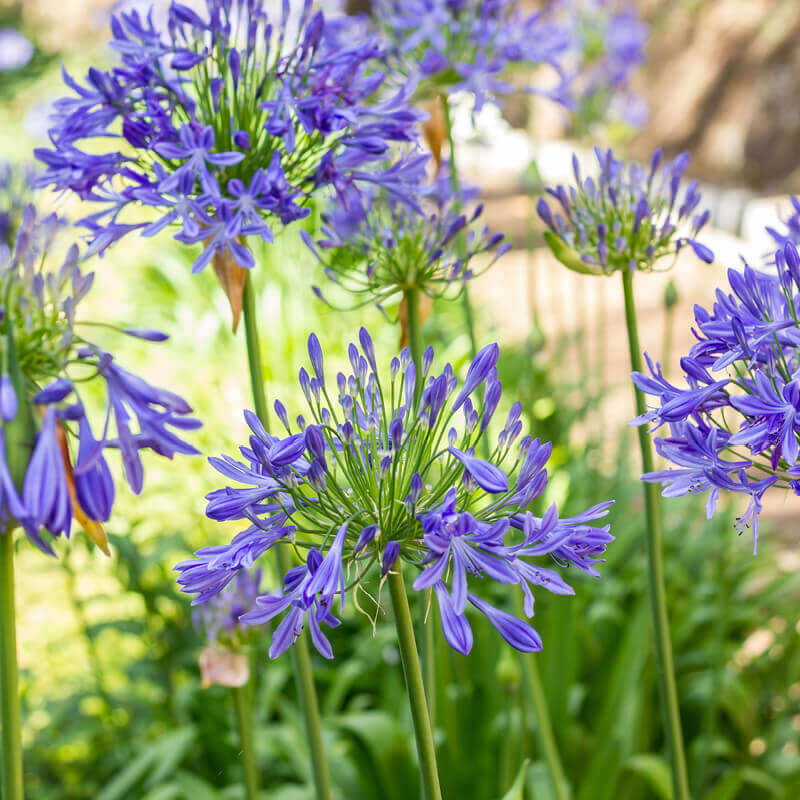Seasonal Agapanthus Treatment: Getting Ready For Wintertime and Summertime
Seasonal Agapanthus Treatment: Getting Ready For Wintertime and Summertime
Blog Article
Mastering the Art of Agapanthus Treatment: Essential Steps for Healthy And Balanced Growth and Dynamic Blossoms
In the realm of cultivation, the farming of agapanthus stands as a fulfilling endeavor for those who seek to support these classy flowering plants. With their striking flowers and stylish foliage, agapanthus has actually captured the interest of gardeners worldwide. However, attaining optimal growth and dynamic blossoms requires a nuanced approach that incorporates numerous crucial steps. From selecting the right variety to grasping trimming methods, the journey towards growing flourishing agapanthus plants is multifaceted and holds the crucial to opening the full capacity of these botanical treasures.

Selecting the Right Agapanthus Range

When choosing the ideal Agapanthus range for your garden, take into consideration aspects such as climate viability, bloom shade, and growth practice. Additionally, consider the climate in your area to ensure the Agapanthus range you pick can thrive in your particular conditions. Comprehending the development routine of different Agapanthus varieties is vital for correct positioning within your yard.
Ideal Growing Problems
Thinking about the optimum ecological demands is crucial for effective Agapanthus growing. Agapanthus plants are delicate to cool temperature levels and ought to be shielded from frost throughout winter months.
To make sure healthy growth and vibrant flowers, plant Agapanthus light bulbs at a deepness of regarding 2-4 inches and space them 8-12 inches apart. Adding organic matter, such as compost, to the soil can boost drainage and fertility, advertising robust root growth. Mulching around the base of the plants aids retain moisture and subdues weed growth. Normal watering is critical, particularly throughout the growing period, to keep the soil continually wet however not saturated.
Watering and Feeding Tips
Preserving correct dampness levels and supplying vital nutrients are crucial elements in the care routine for Agapanthus plants. When it involves sprinkling Agapanthus, it is important to strike a balance. If overwatered, these plants favor consistently wet soil however are prone to root rot. Throughout the expanding period, water deeply as soon as a week, guaranteeing the dirt is well-draining to avoid waterlogging. In hotter environments or during periods of dry spell, even more constant watering may be required to maintain the soil equally damp. Nevertheless, decrease watering in the wintertime to stop water logged conditions.
Feeding Agapanthus is essential for promoting healthy and look here balanced growth and respected flowers. Use a balanced plant food, such as a 10-10-10 formula, in the early spring as brand-new development emerges. By adhering to these watering and fertilizing ideas, you can ensure your Agapanthus plants prosper and produce lively, lasting blooms.
Pruning Methods for Agapanthus
Trimming Agapanthus plants at the proper times and with correct techniques is vital for maintaining their health and advertising optimum growth and flowering. The perfect time to prune Agapanthus is in late winter my response months or very early spring before new development arises.
Deadheading spent flowers can also reroute the plant's energy right into creating more blooms instead than establishing seeds. If you want to collect seeds for breeding, leave some flowers to completely dry and mature on the plant.
Keep in mind to use clean, sharp tools to make accurate cuts and reduce the threat of introducing diseases. Agapanthus. Regular pruning will certainly help maintain your Agapanthus looking neat and healthy and balanced while making sure a bountiful display of beautiful flowers
Managing Typical Insects and Conditions
After making certain correct pruning methods for Agapanthus, it is crucial to deal with usual parasites and diseases that can influence the health and wellness and vitality of these plants. One typical parasite that affects Agapanthus is the Agapanthus gall midge.
One more typical issue is fungal leaf spot, which provides as dark sores on the leaves. To stop fungal illness, make sure good air blood circulation around the plants, avoid above watering, and eliminate any infected fallen leaves promptly. Additionally, Agapanthus plants can experience origin rot if they are grown in poorly browse around this site draining soil. To avoid this, plant Agapanthus in well-draining soil and stay clear of overwatering. By being attentive and taking timely activity versus diseases and bugs, you can help your Agapanthus plants thrive and generate vibrant flowers.

Conclusion
Finally, understanding the art of agapanthus care involves choosing the best range, supplying perfect planting conditions, proper watering and feeding, suitable trimming techniques, and attending to typical pests and conditions. By adhering to these crucial actions, you can guarantee healthy and balanced development and vibrant flowers for your agapanthus plants. Keep in mind to frequently check and keep your plants to advertise their total health and long life.
To ensure healthy and balanced development and lively blooms, plant Agapanthus light bulbs at a depth of regarding 2-4 inches and room them 8-12 inches apart. By adhering to these watering and fertilizing tips, you can ensure your Agapanthus plants grow and create vibrant, durable flowers.
One common parasite that affects Agapanthus is the Agapanthus gall midget. Additionally, Agapanthus plants can experience from root rot if they are grown in inadequately draining soil. By complying with these essential actions, you can ensure healthy development and vivid blooms for your agapanthus plants.
Report this page